16 January 2024
User discovery made Carrofina's app useful, fail-safe, and marketable
Testing business and design requirements is a must to reach high user adoption and retention. Carrofina maximized their app’s value even before software development by cooperating with TSH’s Product Designers.
About Carrofina
Carrofina is an American company behind an e-commerce platform that transports overseas orders from the USA to Poland by booking free space on container ships. Carrofina and The Software House partnered up to create a highly customized e-commerce platform for people who want to buy goods in the US but are overwhelmed with paperwork, taxes, etc.
The final product removes obstacles from the customers’ journey. It’s so user-friendly that shoppers don’t have to worry about a thing.
The entire design process lasted 7.5 months with two design rounds. Supported by the project manager and DevOps, we worked in a dream team of a backend developer, frontend developer, product designers, and quality assurance.
From the client’s side, we cooperated with a great product owner and investor’s representative.
Read more about the future-proofing Carrofina application:
Rethinking what seemed a neat product idea
Carrofina had some market-fit doubts, and they didn’t want their business idea to fail because of a lack of user interest. The niche product idea in the transportation market should sell itself, right?
Our team knows that even the best ideas and biggest market players (e.g. Zalando) always go through evolutions made possible by the product discovery process.
Product evolution, much like natural evolution, eliminates faults and bolsters the features that make a product faster, stronger, more effective — and more likely to survive on the market. The gains are never immediate but they keep the user rate growing in the future.
We had every confidence in Carrofina’s business side. Still, we needed to set some stuff straight:
- Carrofina didn’t have a defined user proto-persona, so their target user definition was murky.
- User research. There needed to be more clarity on why people would use their digital service (are the benefits offered enough?).
- What would the end-user care about – service quality or price?
- Who are Carrofina’s direct competitors? Is it more like AliExpress or FedEx and UPS?
- What goods from the USA do people want to buy?
Client workshops
We began our journey by gathering and understanding the business requirements, ensuring they were aligned with the project’s goals. To guide our efforts effectively, we followed these important questions:
- What exactly are we doing?
- Why are we doing it?
- What customers are we doing it for?
- Which customer group is the priority?
By seeking detailed answers, we stayed focused and ensured that our actions were purposeful and aligned with the overall objectives of the project. We created a sense of security and transparency, by clarifying responsibilities within the team, so everyone is well-informed about their roles and tasks. This, in turn, laid the foundation for better communication and collaboration among all project members.
To develop a successful system, we outlined the main functionalities that it should possess. This helped us stay on track to build a robust and efficient solution addressing the pain points of our target customers.
In setting our goals and defining the functionalities, we also acknowledged the potential risks and limitations that could hinder our progress. By identifying and listing these challenges, we remained realistic and proactive in addressing them, understanding that the journey ahead wouldn’t always be smooth sailing.

With this comprehensive approach, we could confidently navigate the project and achieve a truly impactful outcome.
Scope of work for The Software House product designers
Our goal was to create a responsive web design landing page for Carrofina that provides customers with all the necessary information in a trustworthy and simple manner.
The web application required two panels for:
- customers – making purchases, tracking packages, contacting the company, and updating personal information.
- operators – facilitating orders and managing customers.
Throughout the development process, we emphasized the safety of all systems, as our stakeholders were aware of the importance of data security and the risks associated with personal data breaches.
Critical product discovery process
By investing five weeks in optimizing their service with The Software House’s product designers, Carrofina learned business-wise:
- Who is their actual target audience?
- What are their user’s pain points?
- What are the wins and losses of their direct and indirect competitors?
- What should be the must-have features of their minimum viable product?
Step 1 – competition research and customer feedback
The client analyzed the most prosperous competitors and their business models. The differences and similarities between their and Carrofina’s models revealed one key fact.
Most companies with country-to-country shipping depend on a linear process — they dispatch all packages with users’ products into one warehouse. After repacking, they prepare them for one or a few international shipments, helping the users avoid outlandish costs.
How do users feel about these competitors? A loud majority was displeased with the inferior quality of service, long delivery times, and hidden fees.
We concluded that Carrofina’s advantage would come from outstanding customer service that works at a speed with no hidden fees.
Step 2 – customer interviews
In-house product research is biased. So there was no other way but to test our assumptions with real end-users. We arranged for several user interviews following the same scenario.
- Small talk
Creating rapport with the interviewee is important when trying to dig up insights.
- Discussing e-shopping habits
We asked about their purchasing motivations and uncovered the most memorable experiences and emotions.
- App prototype testing
To review the idea for the service using the prototype we made and reveal any user confusion or feature wishes.
- Interview round-up
The interviewer measured product satisfaction and inquired about trust in the new brand and the added value that would encourage service use.
Step 3 – user groups & customer persona
The design team looked for specific products Carrofina’s best-fit audience shops for and how often they do it. User feedback revealed people buy foreign goods through family or friends who live in countries where such goods are available. If they have no personal connections, they reluctantly use international shipment solutions (similar to Carrofina, often, leaving customers displeased.
The findings allowed us to establish three new user groups previously unspecified by Carrofina:
- digital nomads,
- expats,
- collectors.

Based on our discovery phase and the knowledge provided by stakeholders, we determined that Carrofina’s initial target audience would be people in the United States who require shipping of Polish products to the US. Additionally, there would be a secondary focus on Polish individuals who need shipping of goods from the US to Poland.
The company already has many customers, primarily expats residing in the US, who have been purchasing building materials such as windows and flooring from Poland. These customers have found it economically advantageous to buy such products from Polish stores and have them shipped to the US due to the favorable quality-to-price ratio.
We also aimed to cater to individuals purchasing specific products from stores that do not offer direct international shipping, such as specialized sports equipment.
The stakeholders already have plans to target a wider audience and explore additional markets after the post-MVP phase.
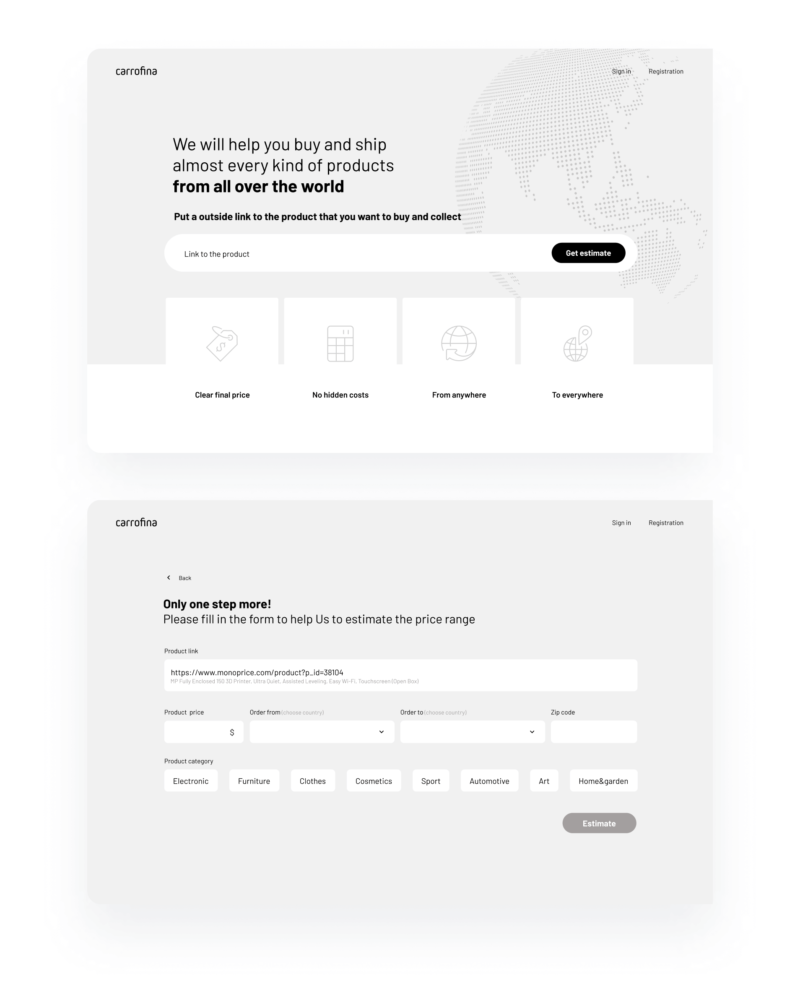
User flow
Creating a user flow was crucial in ensuring a seamless user experience. This process involved multiple iterations where we considered users’ actions, needs, and goals at each step.
Through consultations with developers and stakeholders, we gathered valuable insights and feedback to refine and improve the user flow. Once our team had the ready user flow, it served as a structured guide for our work, clarifying the system we were building. This not only helped us align our efforts but also enabled everyone involved to have a better understanding of the overall scope and functionality of the application.
Application’s logic
Developing a product requires an individual approach. In this particular case, we needed to address the question of which statuses would be most suitable for package tracking.
While there are several companies, such as InPost, UPC, and FedEx, that offer package tracking capabilities, none of them approached it in the unique manner that Carrofina envisioned. As a result, it became necessary for us to engage in business analysis and brainstorming sessions with stakeholders to identify the company’s needs and create labels that align perfectly with the distinctive nature of Carrofina’s delivery service.
It was challenging as the service was still maturing, and we didn’t have much data to rely on. But after a few meetings, we laid a strong foundation for the future evolution of the package’s journey with Carrofina.
MVP Design
Minimum Viable Product (MVP) design’s focus was on the key business aspects – order placement and payment flow.
Additionally, we recognized the need to effectively explain the service to customers, so we dedicated extra attention to the info page.
Moreover, we developed a basic version to provide customers with package status updates and facilitate easier communication with Carrofina’s staff. Similarly, operators received the option to manage the purchasing and shipping process.
Collaborating with the stakeholders, we made decisions regarding the visual language for the service. We opted for a friendly feel, incorporating rounded corners and playful orange lines and color blobs. To add a touch of seriousness, we complemented the design with black accents. For visual separation, we used a delicate pale blue shade sparingly.
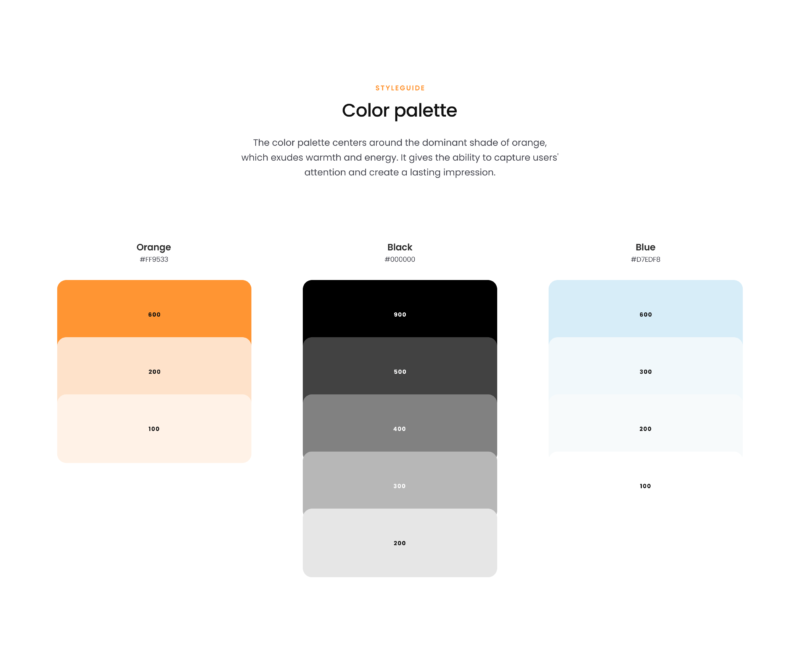
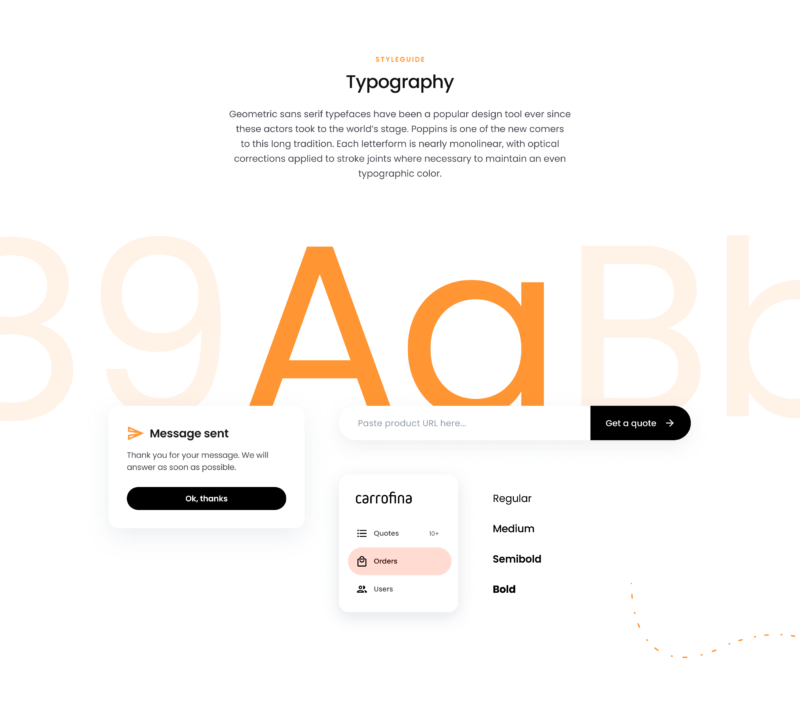
To ensure a positive user experience, we meticulously designed the website to be responsive across all devices, including desktop, tablet, and mobile. Since the website serves as the initial point of contact with Carrofina’s service, it was crucial to make a good impression, regardless of the device used.
As the proverb goes, “You can make a good first impression only once”, and we certainly didn’t want to undermine that impression with poorly scaled images or buttons difficult to click, placed in inconvenient positions. After all, that click is vital to Carrofina’s business success!
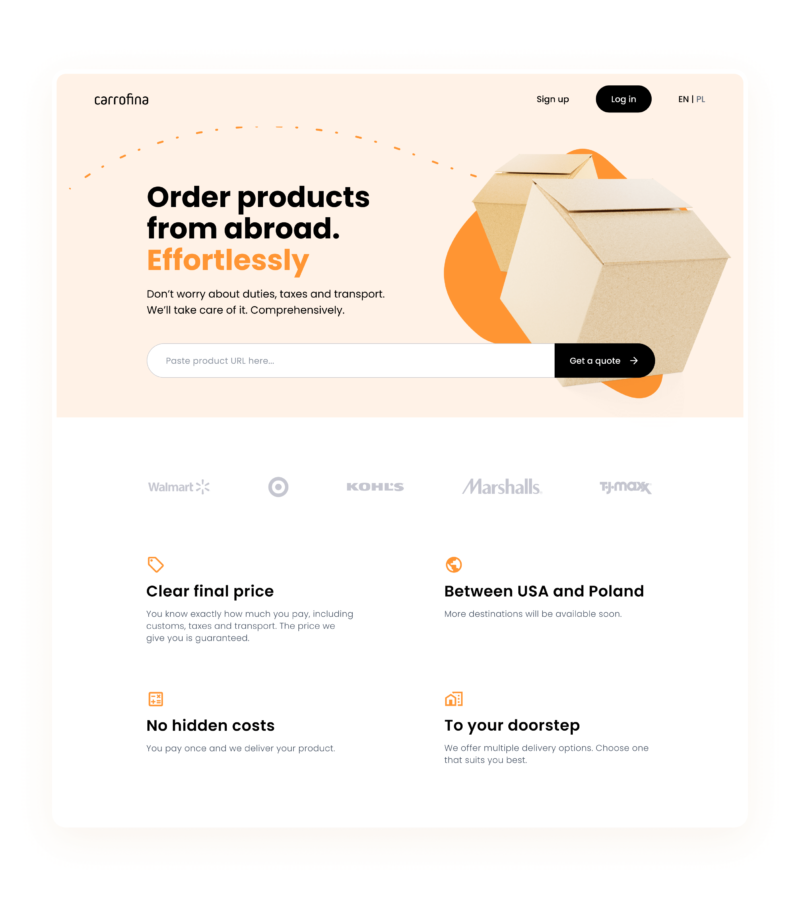
Friends & Family Design (Post-MVP)
After completing the MVP stage, Carrofina’s stakeholders decided to continue cooperation with The Software House. Our team began working on the next “Friends & Family” milestone. This stage aimed to refine the MVP version and prepare it for the first major launch.
We introduced improvements in layouts – neatly organized information about the purchases and package history with comments ensured the customers could easily manage a larger number of orders.
We made responsive web design (RWD) not only for the website but also for the mobile application. With mobile traffic growing year-on-year, mobile aesthetics become essential to stand out in the crowd.
Based on feedback from the MVP phase, we expanded the functionalities in the operator panel – adding tags to facilitate easier product categorization and developing a more robust and comfortable pricing panel. We also created a business setup feature to customize certain options without involving software developers for minor changes. This is a fast and efficient option, not to mention a lot of money savings for Carrofina.
Furthermore, we also introduced choosing the delivery method for end-users. Now, a customer has the option to select a faster but more expensive delivery option. Or when time doesn’t matter, they can save some money and wait a bit longer for their package.
With a more polished product in hand, we were ready to put it to a test – a usability test.
Usability testing
User testing paid off in this project. We conducted a moderated usability study with participants carefully selected to resemble the end users of Carrofina’s service. These participants needed to meet specific criteria such as language skills, income level, and digital literacy. The recruitment process played a significant role in ensuring that we obtained accurate results.
HINT! A common mistake we often observe in usability studies is including individuals who do not represent the target user group. That almost always leads to incorrect findings.
Conducting a moderated study allowed us to gain insights into the reasons behind user behavior. We were able to understand why users deviated from the expected path, their concerns, and their emotional experiences during the ordering process. Armed with this knowledge, we were able to make improvements to the service, making it more functional and enjoyable for users.
We discovered that users mostly valued personal contact with the company, especially when purchasing expensive products.
Other findings were equally surprising. Some users wanted Carrofina to participate in auctions on their behalf. Say, you want to buy a car in the US and get it shipped to your doorstep in Poland. The only problem – it’s an auction. But why not specify your highest bid to Carrofina’s operator and let them get the job done for you? Not we, nor Carrofina themselves haven’t even thought about such a use case before! And that wasn’t the only idea for the future growth of Carrofina’s business, we discovered but it’s hush-hush for now.
The final product

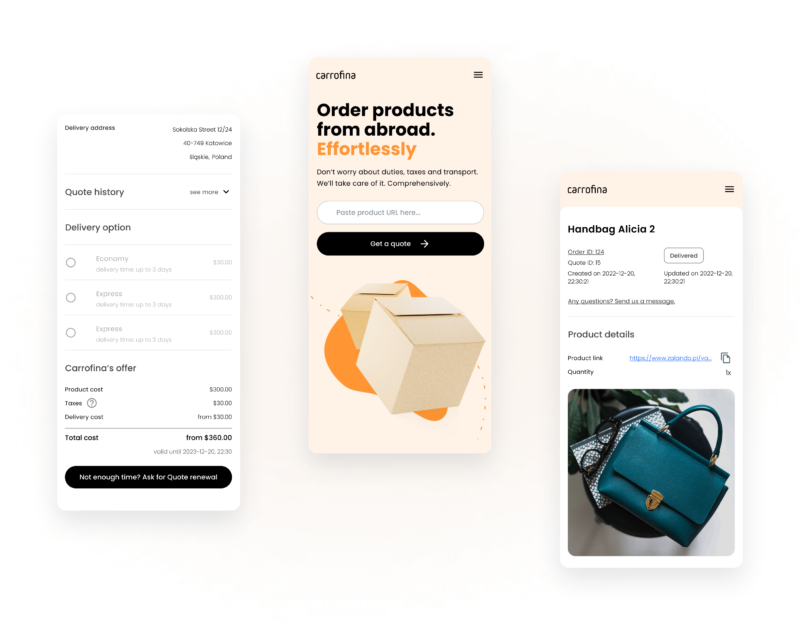
Project benefits
Business:
- via product discovery, it turned out that the initial business model needed crucial adjustments,
- has a strong foundation for future development of the platform,
- established a strong target group of end-users and their specific needs,
- learned specific situations people use their service in, hence providing a product based on user needs,
- know how they differ and stand out from the competitive platforms.
End-users:
- ship products without worrying about duties, taxes, etc.,
- receive a tested and easy-to-use service,
- our security specialists took great care of the high-end safety of personal data.
The development team/operators:
- specify parameters like shipping methods in the Business Setup panel,
- save time by automated e-mail sending,
- tag orders,
- export all data related to orders to spreadsheets,
- see automatically fetched OG images, titles, and shop names.
Customer testimonial
“The Software House helped us to build the MVP version of our web application. The team supported us at every stage of the SDLC process including basic UI/UX setup. With the MVP version of the Carrofina app, we were able to start the validation of our business idea during the Friends & Family phase. Cooperation with the project team was extremely well organized. Currently, we are working with TSH on the final version of the app and we are jointly planning the technical roadmap”
“Code first, think later” is a recipe for a headache
Cross-functional collaboration with some observable designers goes a long way. Spare your developers that awful feeling when they receive a wall of post-launch ASAP fixes instead of further working on product improvements.
The product discovery phase takes some effort but you will have a clear view of developing handy software. The constant improvement simply reflects the need to catch up with the ever-changing markets and technologies.
By trusting the process, Carrofina gained additional insights and that leveled up their service’s quality even before it was launched. This saved them big money usually spent on fixing unforeseen issues that appear post-launch.
After a few months of diligent work, we laid a strong foundation for the future growth of Carrofina’s service. The stakeholders have ambitious plans, and we are happy to see the business catch the wind in the sails.
If Carrofina jumped right into development, users would probably point out the missing parcel tracking in their reviews. For a business, it’s a low-priority feature, but it’s critical for users in the international shopping niche.
After the app’s release, Carrofina will continue measuring user satisfaction, verify assumptions, and develop a deeper understanding of its target audience.
To make your app user-friendly, you need to think like your customers
Our Product Design team armed with thorough business analysis makes sure your product is marketable too. Consult your idea by dropping us a line below. We’ll get back to book 1-h conversation – always free of charge!


